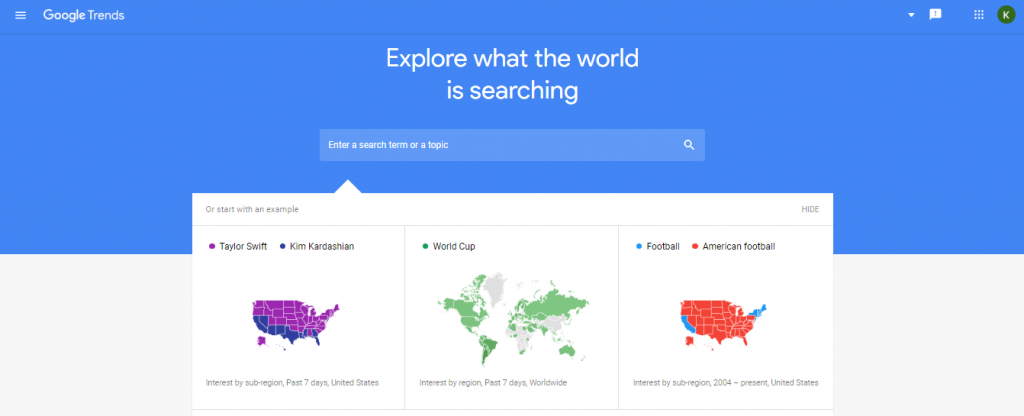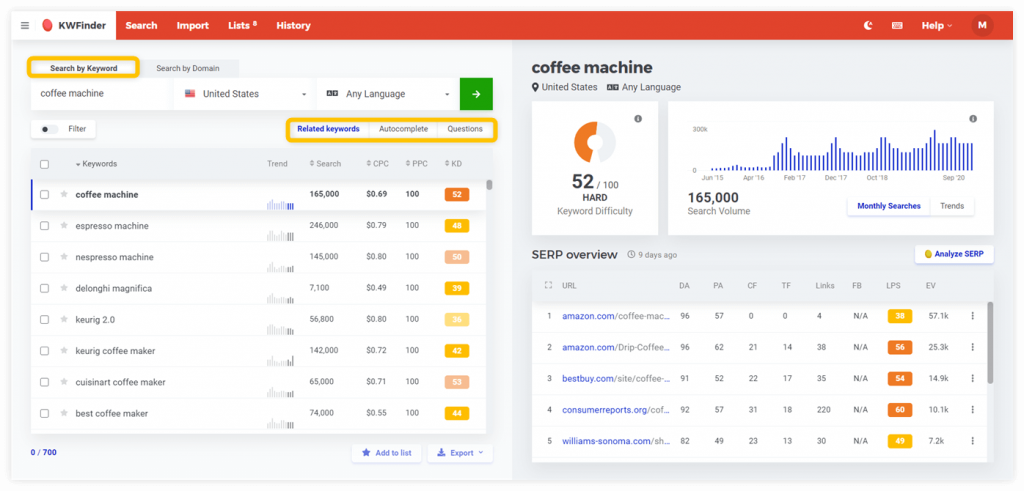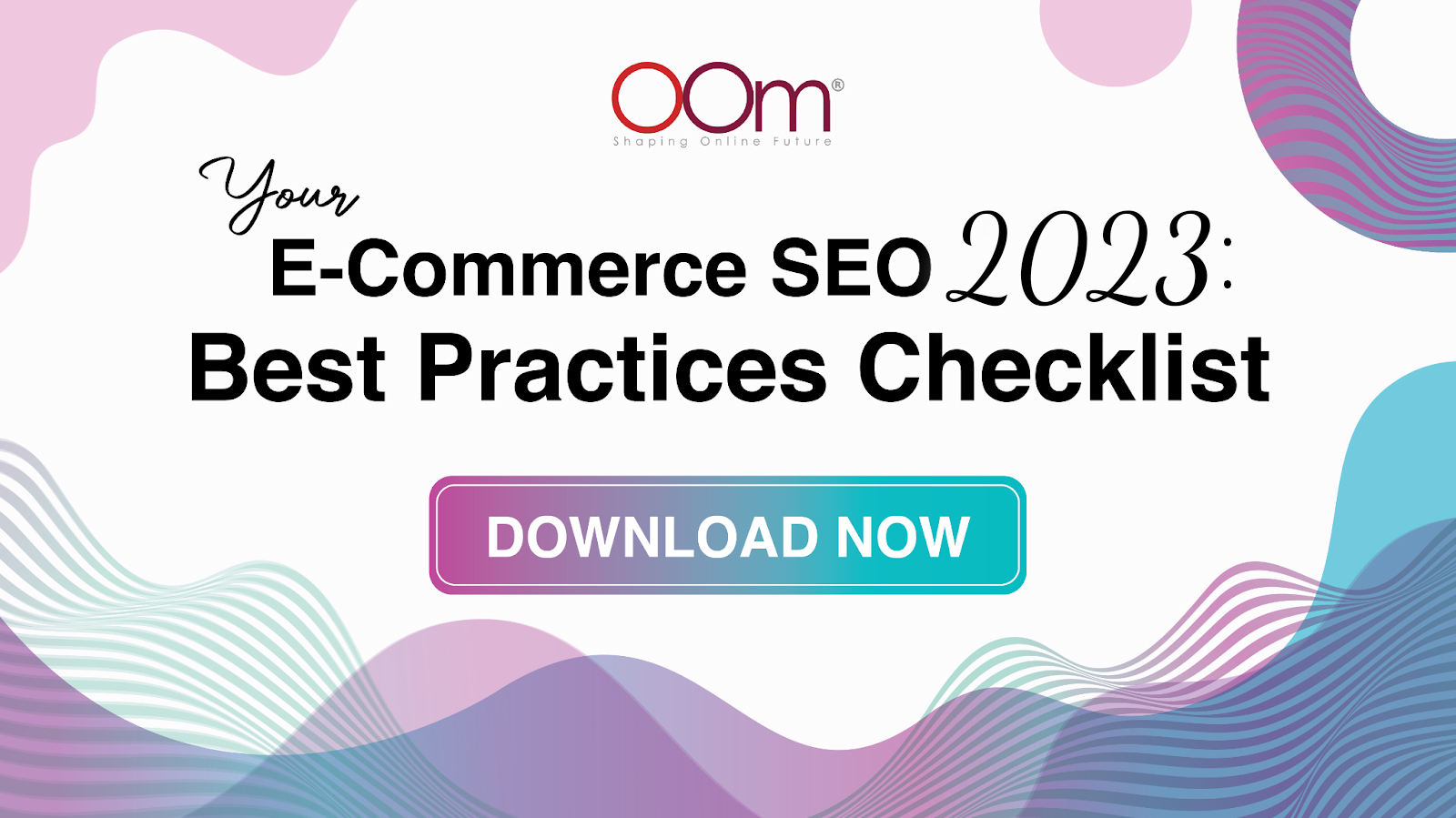Search engine optimisation (SEO) is the most relevant digital marketing strategy. No matter what type of business you own, SEO is a tactic that can help you succeed in attracting traffic, gaining leads, and boosting sales.
For online businesses, SEO is even more essential. Driving traffic to your e-commerce website is almost impossible without following proper and the best SEO practices for e-commerce . Focus on building an SEO-friendly e-commerce website to attract more customers and improve your online presence.
However, the world of SEO is constantly changing. Trends and updates come and go all the time. SEO tactics that are effective today might be obsolete tomorrow. When it comes to e-commerce SEO, there is no difference. You have to watch out for the latest best SEO practices for e-commerce.
If you are new to the e-commerce industry and plan to implement SEO, understand the best practices for e-commerce that can help your online business expand and grow. Here is a checklist for the best SEO practices for e-commerce.
15 E-Commerce SEO Best Practices To Increase Traffic In 2023
1. Perform Keyword Research
The first action you need to take based on our checklist of the best SEO practices for e-commerce is to perform keyword research. It is a vital technique that can help improve the organic search engine ranking of your e-commerce website.
Performing keyword research allows you to uncover the words, sentences or phrases that people search online related to your e-commerce business. If implemented correctly, you will be able to understand your customers’ intent by looking at the keyword search volume.
It will also help your e-commerce website and its web pages appear more on search engine result pages due to their relevance.
The ideal keywords to use on your e-commerce website should have high volume and low competition. That means that the average monthly search volume for a term is large while the competition to rank for those keywords is low.
ALSO READ: Keyword Research Guide: Identify The Right Keywords To Optimise Your Digital Marketing Campaigns
Here are some tools you can use that can help you perform keyword research for your e-commerce website.
2. Optimise Meta Title And Meta Description
Quality content is a determining factor that draws customers to your products and persuades them to purchase. Besides using high-quality images, you can add unique content to your product pages.
Start by using the keywords you have researched for your title tag and meta description of each web page, and make sure they are within their character count limit of 60 characters and 160 characters respectively.
When describing your product on your e-commerce website, the ideal product description word count is around 300 to 400 words. It should have all the vital details that describe your product’s features, qualities, and benefits to influence and persuade potential customers to purchase.
To boost the search engine rankings of your e-commerce website, try using internal links to redirect visitors to other web pages on your e-commerce website. Doing so should help you rank higher for your chosen keywords and improve the user experience (UX).
READ MORE: 4 Ways To Utilise Internal Links To Optimise Your SEO Strategy
3. Allow Customer Reviews
The next thing on our SEO practices for e-commerce checklist is to allow your customers to leave their views and opinions on the products they have purchased from your e-commerce website, this will help to boost the conversion of your product pages. According to PowerReviews, 95% of consumers often read customer reviews before making a purchase.
Here is an example of adding a customer review feature on a product page from Sephora Singapore.
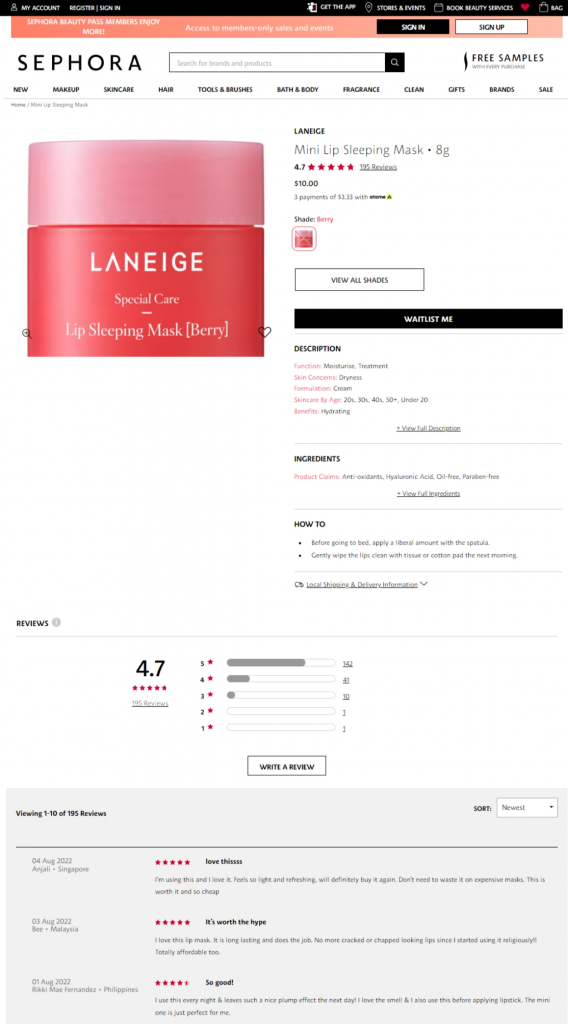
Consider adding this review feature to your e-commerce website to help your customers to give feedback about their purchases. With past customers’ feedback, other potential customers can weigh their options as they learn the pros and cons, which can help them make an informed purchase decision.
LEARN MORE: Customer Reviews: How To Use Them In Your Marketing Campaigns
4. Simplify Your E-Commerce Website Architecture
The architectural design of your e-commerce website plays a vital role in search optimisation. You should have a user-friendly website architecture that allows fast payment and transactions for your potential customers not to shorten their purchase journey.While they have a high interest in shopping from your e-commerce website, it is better to keep your customers engaged by showing relevant products based on their preference so they can purchase more and you will make more conversions.
The only way to ensure their way back and get into their desired web page is to have a sitemap. It is like a list, allowing anyone to know the web pages and how to get there.
Here is an excellent example from Adidas to give you an idea of what a sitemap should look like on an e-commerce website.
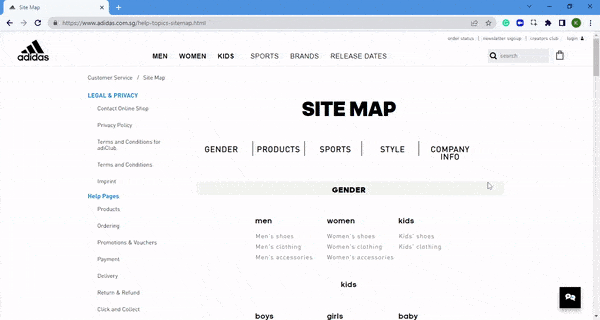
When creating a sitemap, start from your homepage to the web pages of your product categories and sub-product categories. The architectural design of your e-commerce website should be easy to follow if you create your sitemap this way. Otherwise, search engine crawlers like Googlebot and visitors will have a hard time going to and indexing the web pages of your e-commerce website, which can affect your rank on SERPs.
5. Resolve Technical SEO Issues
Are you sure that your e-commerce website is SEO-friendly? Find out by conducting an e-commerce website audit that will let you identify any present technical issues on your e-commerce website.
Here are some of the potential technical SEO issues your e-commerce website might be having:
- Slow loading times
- Duplicate content
- Missing title tags and meta descriptions
- Non-existing XML sitemaps
These technical SEO issues can harm the performance of your e-commerce website, SEO strategies, and search engine rankings, so you should resolve them as soon as possible.
For instance, to eliminate duplicate content on your e-commerce website, you should ensure each product page contains unique and original content. As for improving your e-commerce website speed, you can optimise your images and remove unnecessary plugins that potentially are slowing down your website.
ALSO READ: What Should Your Website Auditing Checklist Have?
Better yet, engage with an e-commerce SEO agency in Singapore and let them do an SEO audit report on your e-commerce website for free.
6. Use Proper URL Structure
Another one of the best SEO practices for your e-commerce website is to use proper URL structure. The term ‘URL’ refers to Uniform Resource Locators, which are the text written on the address bar of a web browser.
The URL of a web page is the first thing that visitors will see as soon as they land on the landing page of your website. Keeping the URL clear and simple makes it readable to potential customers.
Here is a good example of an optimised URL from MAC Cosmetics. This beauty retail brand optimised its URL by being concise about the content of its web page, which helped ease the search process of buyers.
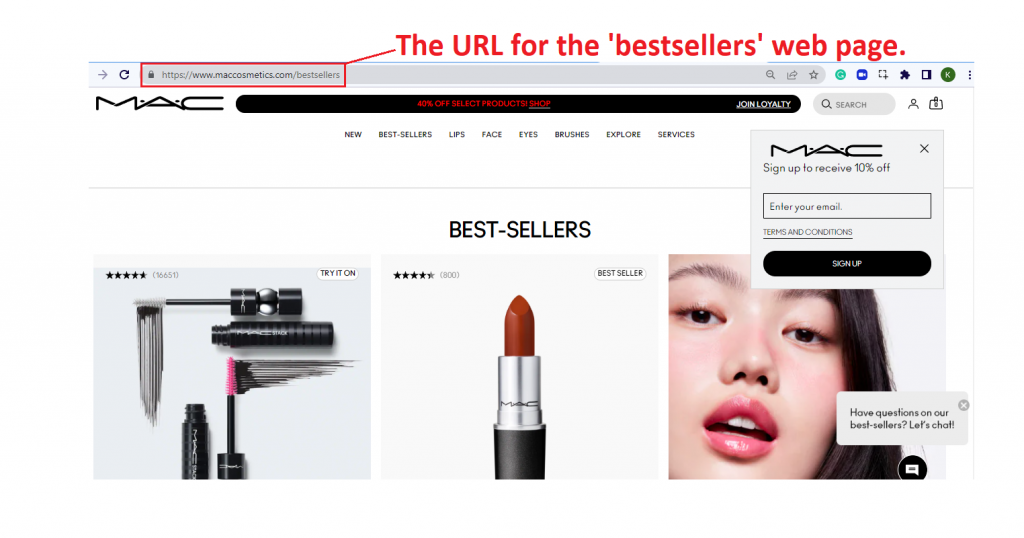
With proper URL structure, search engines can also index the web page properly, so it will appear to potential customers searching for the exact or related keywords.
For example, MAC Cosmetics has optimised its URL well for the ‘best sellers’ category, Google recognises the keyword, which is why this one shows at the top of SERPs to provide bestsellers of MAC lipstick to the potential consumer searching for it.
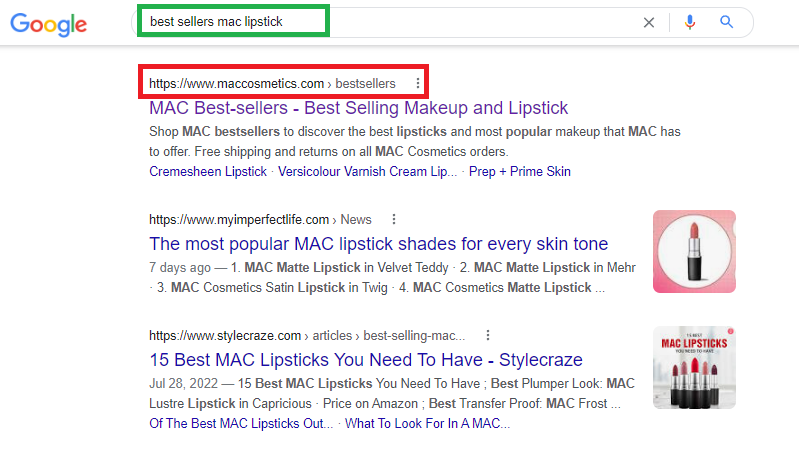
7. Properly Rename Alt Text And File Name Of Images
Have you ever wondered how search engines could provide pictures related to users’ search intent? That is all thanks to alt text and file name.
With file names of images, SERPs can directly show relevant answers related to the content a user has written.
Meanwhile, alt text is the short term for alternate text. It is an HTML attribute for visually impaired users so search engines can read the image through the alt text such as the colour, shape, and even the action images. A search engine like Google can identify the image context through the description of alt text.
Thus properly rename alt text and file names of images before uploading and publishing them on your e-commerce website. Ensure that you are concise and descriptive when explaining the image context.
ALSO READ: Image Title Tags And Image Alt Tags
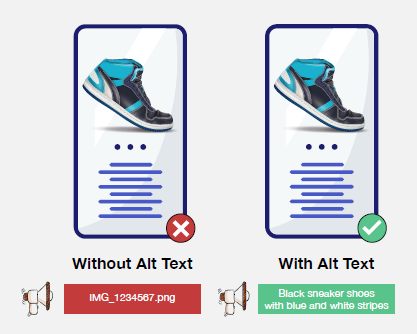
8. Start A Blog Page
You can also increase the web traffic of your e-commerce website by starting a blog page. Hubspot even conducted a survey and found that 58% of businesses that made website blogging their priority were able to generate a huge return on investment (ROI).
READ MORE: The Importance Of Blogging For An E-commerce Website
Given that consumers nowadays are becoming smarter with their purchases, your blog page can help ease their research process about the product or service with relevant information.
Here is a good example of a blog page from Mega Furniture. They have written and shared articles that can help their potential customers weigh their options about the furniture or appliance they want to buy for their homes.

9. Make Your E-Commerce Store Responsive
Many consumers nowadays prefer to shop online, and among online shoppers, statistics have shown that half of the global web traffic comes from mobile devices.
If your e-commerce website is not mobile-friendly, your potential customers will get frustrated when they come across one of your product web pages but cannot see the images and information of the product properly.
The web design of your e-commerce website should be responsive to make it mobile-friendly. That implies that it can automatically adjust to the user’s device, be it a smartphone or tablet.
ALSO READ: Mobile SEO: A Guide To Optimising Your Website For Mobile Phones
The image shown below displays a responsive web design of an e-commerce website on various screen sizes.

10. Add A Customised 404 Error Page
The last practice to follow on the e-commerce SEO audit checklist is to add a 404 error page. The term ‘404 error’ refers to a code status that shows a potential customer the web page they want to access is unavailable due to a broken link or mistype in the URL.
However, that is not the only purpose of adding a 404 error page. If done right, it can prevent customers from leaving the website by suggesting popular web pages that customers might be interested in checking to continue their purchase journey.
For example, in this image, Zappos, an online clothing retailer, recommended several web pages to simplify their customers’ search.
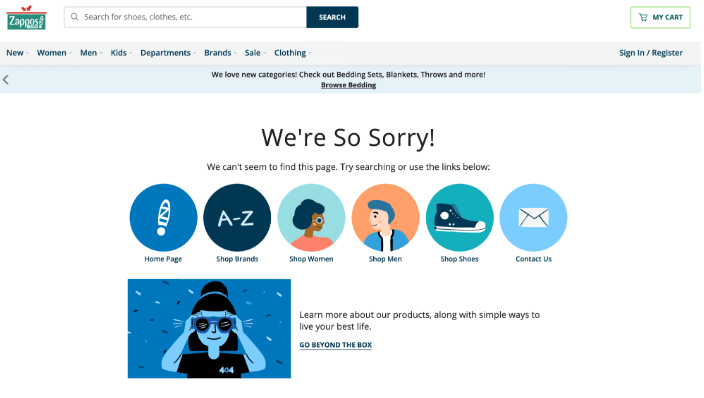
11. Optimise Product Description
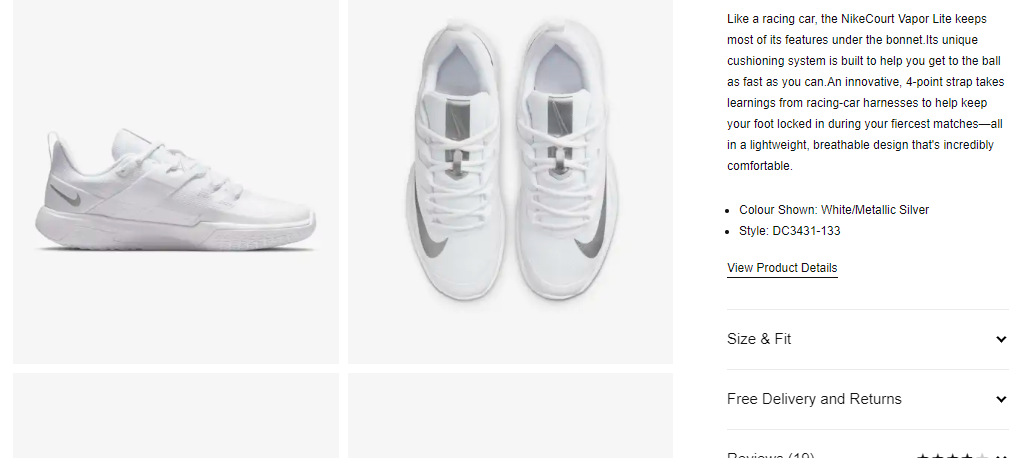
An example of product description of Nike shoes.
A product description is a short copy or a piece of writing that describes the product or service and explains its benefits. The primary goal of the product description is to provide consumers with information, facts, and stories about the product or service that will convince them to make a purchase.
The pieces of information a product description contains are the following:
- Physical description – Colours, materials, size, components
- Key Benefits – Key feature of the product or service or a paragraph that explains why the consumer needs the product.
- Motivation – Review, social proof, motivation
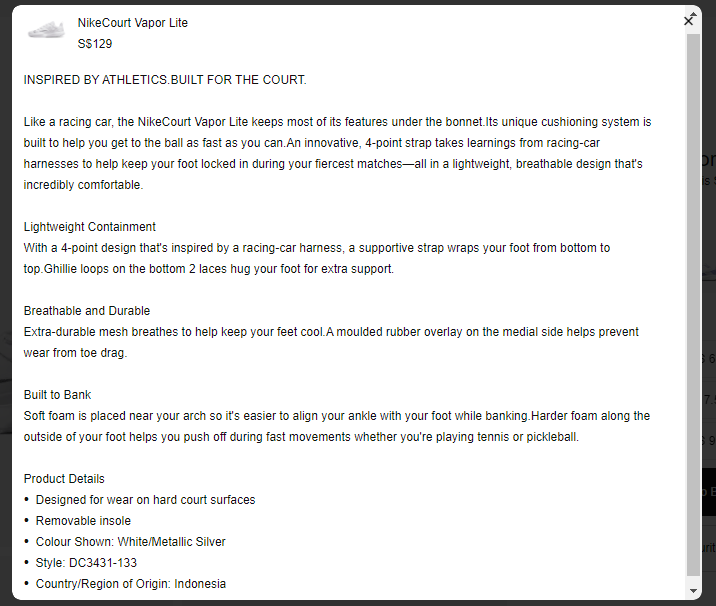
An elaborated product description of a Nike shoes
The trick to optimise your product description for e-commerce SEO in Singapore is to apply keywords. Keywords and search phrases increase the chance of your product page to rank. However, avoid keyword stuffing, as it can also harm your page.
Remember, product descriptions have a limited word count. Make sure your description is brief, detailed and precise as it can be so they are helpful and relevant to your consumer.
One of the greatest mistakes in e-commerce SEO for product descriptions is copying the manufacturer’s description. There is a high chance that this description has already been uploaded. It could be flagged as duplicate content. As much as possible, create original and unique product descriptions.
12. Avoid Duplicate Content
Duplicate content is a piece of writing uploaded on websites that are similar to exact copies of other content. It can also be a block of content or the entire content itself. It can be a blog post, product description, and other content on the website.
Duplicated content can be intentional or not. Nonetheless, it hurts your SEO and does not belong in e-commerce SEO best practices. To begin with, duplicate content confuses search engines, letting them decide which of the two pages with the same content to rank. Remember, search engines do not show identical results at the same time.
Using canonical tags can help you skirt around the issue. What canonical tags do is tell search engines that the page with duplicate content is a copy of the original page it credits. Therefore, the traffic and backlinks the duplicate page receives must lead to the original page.
On the other hand, the no-index meta robot tags tell search engines like Google not to index duplicated content. When a certain has not been indexed, the search engine will not show them on the search results. An e-commerce SEO agency can help you with this trick.
13. Make Use Of Internal Links
Internal links refer to the links hyperlinks to anchor texts that lead you to other content within your website. Anchor text is highlighted or underlined clickable text in the content Interlinking is one of the best practices in SEO and e-commerce website development.

How can interlinking benefit your e-commerce SEO? Besides excellent e-commerce website design in Singapore, internal links ensure your website visitor remains on your website
For example, they visited your product page about slimming coffee. Instead of leaving your website to search for the benefits of slimming coffee, interlinking your article about the advantages of slimming coffee on your product page prevents website abandonment.
Using hyperlinking or making keywords your anchor text can help increase traffic to certain pages and reduce bounce rates, in addition to keyword usage.
Content creation is crucial in interlinking. You should have informative and relevant content to interlink all across your websites. After all, you don’t want the traffic to go to other e-commerce websites.
Collection and product pages are the best places to put apply internal links. Research is a great part of making a purchase. Therefore, handing out links to informative content can help consumers decide whether to buy the product or not.
14. Capitalise On The Collection Page
In e-commerce websites, collection pages refer to a website page that contains all the business’s products and services available. It is in contrast to a product page that only contains one product. Categories segregate collection pages. Collection pages also benefit the user experience and e-commerce website design.

Nike’s collection page
Brands can optimise their collection products by applying keywords. For example, they can use descriptive words and phrases people typically use in their queries, such as ‘running shoe women’. It helps the search engine identify the relevance of your collection page.

Nike’s product page
Moreover, you can also interlink your collection page to the blog content of your website. It helps persuade the reader to make a purchase.
15. Invest In Local SEO
Local SEO is crucial primarily because the competition can be less difficult. Moreover, local e-commerce SEO services in Singapore can sometimes be cheaper, benefiting small businesses. Local SEO helps your business stand out in local searches.

An example of Google Business Profile
Completing your Google Business Profile and ensuring the information is identical to what you have on websites and social media can enhance your local SEO strategies.
Search engines like Google tend to rank websites with reviews. Encouraging your local consumers to leave reviews will affect the traffic and conversion rate of your website.
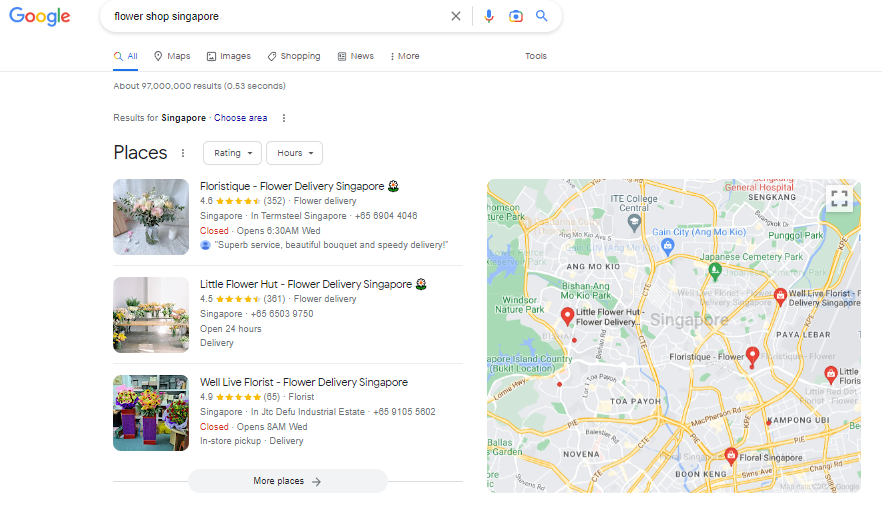
There are several ways to enhance your local SEO. The first is using location-specific keywords. These keywords could be a real location such as ‘Singapore’, ‘New York City’, or ‘SoHo.’ It can also be a phrase such as ‘near me.’
For example, In the image above, the user is looking for a flower shop in Singapore on Google. The following GBP listing of flower shops in Singapore appears with a map and pinpoint locations on the right side, allowing the user to have options for where they should purchase the flower arrangements.
Frequently Asked Questions (FAQs) About E-Commerce SEO Best Practices
You can also optimise images and videos by properly renaming the alt text and images, compressing the file sizes so they will load much faster, and your potential customers will not wait longer.
READ MORE: A Guide On How To Grow Your E-Commerce Business With SEO
Adding these essential web pages should make your e-commerce website SEO-friendly, maximise its online presence, and reach more potential customers.
DISCOVER: E-Commerce SEO: How To Drive Organic Traffic To An Online Shop?
Learn some of them from this SEO guide for 2022.
READ MORE: Ecommerce Platform Vs Marketplace: Which Is Better For Small Businesses?
To learn more about how to market your product on your e-commerce website,
here are some e-commerce marketing trends you should know and consider following.
- Artificial Intelligence (AI)
- User Experience (UX)
- Social Media Shopping
- Voice Search
- Augmented Reality
- More Payment Methods
- Sustainability Becomes More Important
- Customer Awareness
- Conversion Rate
- QR Codes
- Video Marketing
- Live Streaming Commerce
- On-Site Personalisation
- Influencer Collaboration
- Conversational Commerce For Customer Service
- Live Chat Support
Final Remarks
You can implement better SEO by following the best practices in this e-commerce website SEO checklist to increase the traffic to your e-commerce website and improve its online presence.
Creating quality content and optimising your e-commerce website could take a long time, so consider hiring an experienced professional who could help.
For reliable local e-commerce SEO services, contact OOm today at +65 6690 4049 or leave a message on our website today to learn more about the best SEO practices for e-commerce.
